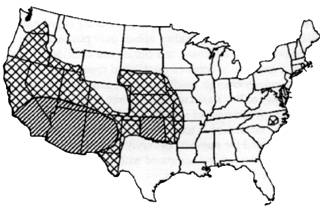| PLANT CULTURE
Greenhouse |
|||||||||||||||||||||||||
| Container .................. | Flat (6 x 31 x 55 cm or similar size) | ||||||||||||||||||||||||
| Medium .................... | Soil mix (eg. 8 parts sand; 3 peat; 3 perlite; 1.4% by vol. lime) | ||||||||||||||||||||||||
| Temp/Light ............... | 22 _4° C; 16+ hour daylength | ||||||||||||||||||||||||
| No. of Plants ............. | 50 to 70 per replicate in rows 3 cm apart | ||||||||||||||||||||||||
| No. of Reps .............. | 3 minimum | ||||||||||||||||||||||||
| Other ....................... | Scarify seed and treat with fungicide to prevent damping-off; sow seed 1 cm deep and cover with vermiculite | ||||||||||||||||||||||||
| APHID COLONY | |||||||||||||||||||||||||
| Source ..................... | Colony consisting of blend of several field collections from area of adaptation, replenished annually | ||||||||||||||||||||||||
| Rearing .................... | Susceptible alfalfa in greenhouse (eg. PA-1, Riley) | ||||||||||||||||||||||||
| Temp/Light ............... | 22+4°C and 16+ hour daylength | ||||||||||||||||||||||||
| INFESTATION PROCEDURE | |||||||||||||||||||||||||
| Age of plant .............. | 1 day after emergence; cotyledon stage; count seedlings at time of infestation | ||||||||||||||||||||||||
| Method ..................... | Sprinkle aphids onto seedlings | ||||||||||||||||||||||||
| Rate.......................... | Minimum of 2 aphids per seedling | ||||||||||||||||||||||||
| Length....................... | Approx. 21 days; spray with malathion or diazinon to terminate infestation; rate plants 7 to 10 days after spraying | ||||||||||||||||||||||||
| Other ....................... | It is critical to maintain temperature
within the range of 18 to 26°C for optimal aphid reproduction and effective resis tance evaluation |
||||||||||||||||||||||||
| RATING | |||||||||||||||||||||||||
| 1 Resistant ............... | Tall, normal trifoliolates | ||||||||||||||||||||||||
| 2 Resistant ............... | Tall, small trifoliolates | ||||||||||||||||||||||||
| 3 Resistant ............... | Moderately tall, small, crinkled trifoliolates | ||||||||||||||||||||||||
| 4 Susceptible ............ | Short; small, crinkled trifoliolates, usually chlorotic | ||||||||||||||||||||||||
| 5 Susceptible ............ | Dead = total emerged- (classes 1 to 4) | ||||||||||||||||||||||||
CHECK CULTIVARS
|
|||||||||||||||||||||||||
|
DISTRIBUTION AND SEVERITY OF Blue Alfalfa Aphid, Acyrthosiphon kondoi Shinji Click on the map above for a larger version. See also the KEY. CORRELATION TO FIELD REACTION Although there have not been extensive comparisons of greenhouse and field results, it appears that levels of resistance are comparable in both situations. BIOTYPES Although biotypes of blue alfalfa aphid are not proven to exist, there is evidence of differential reactions to resistant plants in different locations. HELPFUL INFORMATION Use of cultivars for rearing blue alfalfa aphids that have resistance to spotted alfalfa aphid and pea aphid may help to prevent colony contamination (PA-1). The best procedure for collecting aphids from fields for colony establishment is tapping from infested stems. Fewer will be injured and chances of including natural enemies will be much reduced compared to sweeping. Field-collected aphids should be held in isolation for 2 to 3 weeks to check for presence of parasites. ALTERNATIVE METHOD A field-cage technique has been used for evaluating blue alfalfa aphid resistance in the Southwest. Rows of PA- 1 are planted in plots during fall. In spring, plots are caged and alfalfa is infested by sprinkling aphids over plants. As the aphid population increases, test entries and additional rows of PA-1 are planted between established rows of PA-I. As the test entries emerge, seedlings are counted and estab lished rows of PA-1 are cut back to force aphids onto seedlings. When rows of spring-sown PA-1 have been killed, the infestation is terminated by spraying with malathion, and the numbers of surviving plants in the test entries are counted and compared with original plant counts to calculate % resistant plants. REFERENCES1.
Ellsbury, M.M., and M.W. Nielson. 1981. Comparative host plant range
studies of the blue alfalfa aphid, Acyrthosiphon kondoi Shinji,
and the pea aphid, A. pisum (Harris) (Homoptera: Aphididae). USDA
Tech. 2. Lloyd, D.L., B.A. Franzmann, and T.B. Hilder. 1983. Resistance stages of plant growth to spotted alfalfa aphid and blue-green aphid. Aust. J. Exp. Agric. Anim. Husb. 23:288-293. 3. Nielson, M.W., W.F. Lehman, and R.T. Kodet. 1976. Resistance in alfalfa to Acyrthosiphon kondoi. J. Econ. Entomol. 69:471-472. 4. Zarrabi, A.A., J.L. Caddel, and R.C. Berberet. 1985. Blue alfalfa aphid resistance evaluation as affected by seedling age. Proc. Central Alf. Imp. Conf. 19:26-27.
|
|||||||||||||||||||||||||
